Understanding the Different Types of Domain Locks
To protect your domain from unauthorized access or accidental changes, Bluehost uses different types of domain locks. These security features prevent domain name transfers, changes to registration data, and other updates that could impact the services connected to your domain.
Different Types of Domain Locks
Domain locks serve different purposes—some are optional security features, while others are mandatory based on registry rules. Here's a breakdown of the most common types of domain locks you might encounter:
- Domain Security Lock
- Domain Legal Lock
- Domain Transfer Lock
- 30 Day Lock
- Change of Registrar (COR) Lock
Domain Security Lock
A security lock is automatically enabled on your domain to prevent unauthorized updates or transfers. Changes to nameservers or registrar settings can only be made once the domain owner disables this lock.
Domain Legal Lock
Applied when a domain is under legal review or involved in a dispute (such as bankruptcy or litigation), this lock restricts any changes. You can still renew the domain, but editing or transferring it is not permitted until the legal status is resolved.
Domain Transfer Lock
Enabled by default when you register a domain, the Transfer Lock prevents unauthorized registrar transfers. This ensures that your domain stays within your Bluehost account unless you manually unlock it.
30 Day Lock
A temporary lock is triggered when key account or contact details—such as the primary email or Registration Data Directory Services (RDDS), formerly known as WHOIS information—are changed alongside a password reset. Affected TLDs include:
- .name
- .net
- .org
- .tv
- .us
- .biz
- .cc
- .cn
- .com
- .info
- .mobi
An Outbound Change of Registrar lock (OCRA) can also occur when you update the following information, combined with a password reset; this lock is not a required lock and can be removed at your request.
- The Primary Contact name has been changed.
- The Primary Contact email address has been changed.
- The RDDS Admin Contact email address has been changed.
- The RDDS Admin Contact has been replaced.
- The User IDs are merged in the Account Manager.
- The Primary Contact has been changed.
Change of Registrar (COR) Lock
This ICANN-mandated lock is placed for 60 days after changes to the registrant's name, organization, or email. It helps prevent domain hijacking following ownership or contact information updates.
Triggers for COR Lock include:
- Changing the registrant's name, email, or organization
- Internal domain transfer (Registrant Name Change Agreement - RNCA)
- No registrant email is shown in RDDS (admin email triggers the lock)
- Transfer from one party to another
During the 60-day lock, you can still manage and renew domains or transfer them internally between Bluehost accounts—but not to another registrar.
How to Toggle Domain Lock On and Off
If you need to transfer or move your domain, you can toggle the Domain Transfer Lock:
- Log in to your Bluehost Account Manager.
- In the left-hand menu, click Domains.
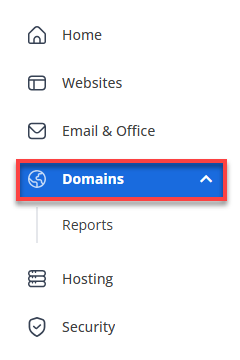
- If you have one domain in your account, you will be taken directly to the domain management panel.
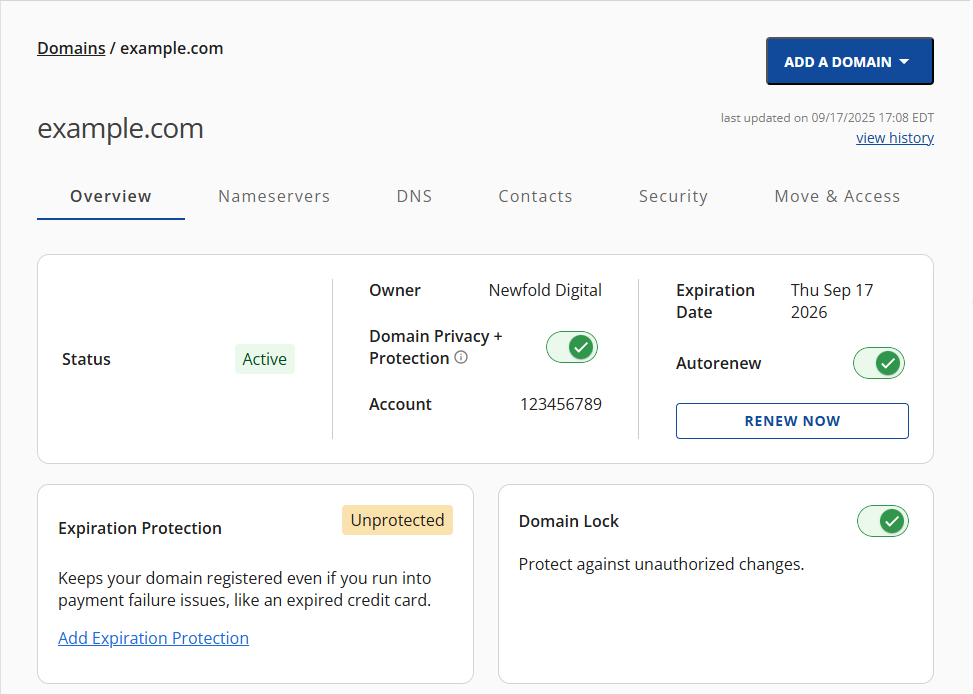
- If you have multiple domains in your account, click the domain you wish to manage to access the domain management panel.
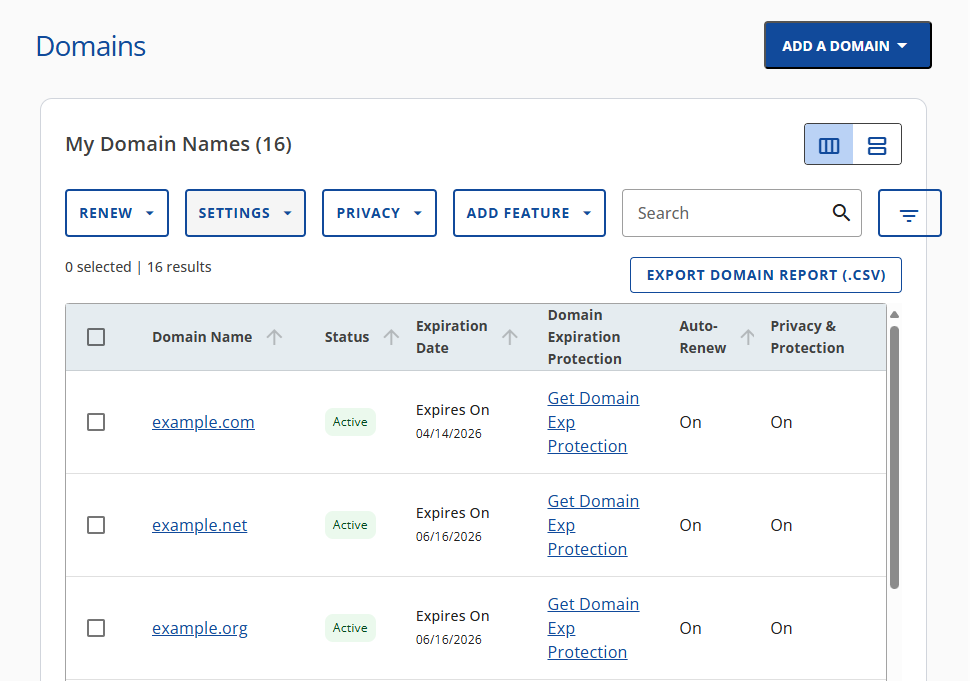
- If you have one domain in your account, you will be taken directly to the domain management panel.
- Scroll to the Domain Lock section.
- Use the toggle switch to Turn On or Turn Off the lock:
- Turn on
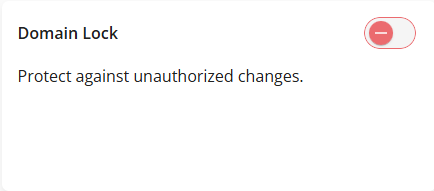
- Turn Off
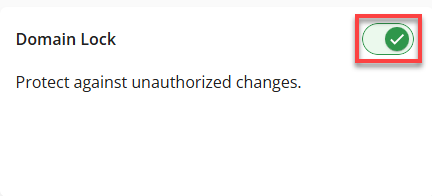
- Turn on
A confirmation message will appear once your change is saved.

Why are Domain Locks Important
Keeping your domain locked is one of the simplest ways to protect it. Without that protection, hackers could redirect your site, mess with your contact details, or worse—take control of your domain. Even well-meaning users can make accidental changes that cause problems.
Frequently Asked Questions (FAQs)
Q: What is a domain lock, and why is it important?
A: By enabling a domain lock, you’re adding an extra layer of protection to your domain name. It restricts changes and transfers to authorized users only, keeping your domain safe from tampering or errors.
Q: How do I know if my domain is locked?
A: To check your domain lock status, log in to your Bluehost Account Manager, go to the Domains section, and select your domain. Under the Domain Lock area, you’ll see whether it’s turned on or off.
Q: Can I transfer my domain while it’s locked?
A: No, you cannot transfer a domain to another registrar while it’s locked. You’ll need to disable the Transfer Lock through your Bluehost Account Manager before initiating a transfer.
Q: What triggers a 30-day domain lock?
A: The 30-day lock is typically triggered when you update certain domain contact information—such as the registrant’s name or email—especially if combined with a password reset. It temporarily prevents transfers for added security.
Q: Is the COR Lock mandatory? Can I remove it?
A: Yes, the Change of Registrar (COR) Lock is required by ICANN and cannot be removed manually. It lasts 60 days after certain contact changes to prevent unauthorized domain ownership transfers.
Q: How do I unlock my domain in Bluehost?
A: To unlock your domain:
- Log in to your Bluehost account.
- Go to the Domains section.
- Select your domain.
- Use the toggle under Domain Lock to turn it off.
Q: Will unlocking my domain make it vulnerable?
A: Yes, leaving your domain unlocked can open the door to serious risks like hijacking or unauthorized transfers. Once you’ve made the changes you need, it’s a good habit to turn the lock back on.
Related Articles
Summary
If you're serious about keeping your domain secure, it's worth getting familiar with the different types of locks available. From the standard Transfer Lock to the COR Lock required by ICANN, each one plays a specific role in keeping your domain safe—whether it's blocking unauthorized changes or preventing someone from transferring it without your permission.
If you need further assistance, feel free to contact us via Chat or Phone:
- Chat Support - While on our website, you should see a CHAT bubble in the bottom right-hand corner of the page. Click anywhere on the bubble to begin a chat session.
- Phone Support -
- US: 888-401-4678
- International: +1 801-765-9400
You may also refer to our Knowledge Base articles to help answer common questions and guide you through various setup, configuration, and troubleshooting steps.